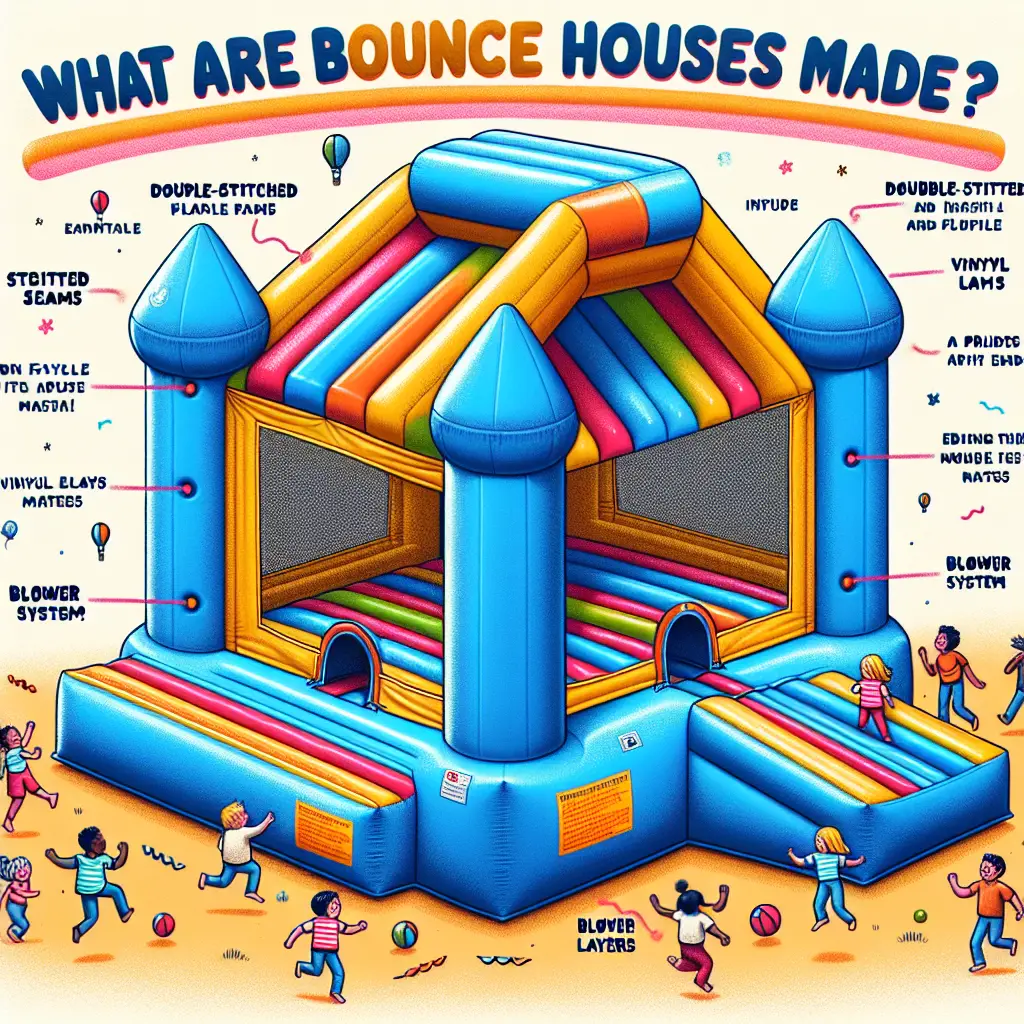What Are Bounce Houses Made Of? – Unveiling The Materials Behind The Fun
Have you ever been to a garden party or a backyard event where a bounce house was the main attraction? Watching the kids jump and play with endless laughter and joy, it’s easy to understand why bounce houses are a staple for outdoor entertainment. But have you ever wondered what these inflatable structures that soar into the sky are made of? In this blog post, we will dive into the materials and construction of bounce houses, so next time you’re at an event, you’ll know exactly what’s beneath those bright and bouncy surfaces.
The Fabric of Fun: Key Ingredients of a Bounce House
1. The “Skin” – Commercial Grade PVC Vinyl
Most commercial bounce houses are made out of a material known as commercial-grade PVC vinyl. This heavyweight material—typically ranging from 18 to 22 ounces per square yard—is the skin of the bounce house. It is incredibly resilient and able to withstand the harsh outdoor elements, like direct sunlight and rain, as well as the constant abrasion of little feet jumping up and down.
PVC vinyl is also easily sanitized and cleaned, which is essential for a structure that is used by numerous children. It’s a trusted material in the industry, considered to be the gold standard for its durability. For more technical information on PVC vinyl, Specialty Textiles Inc. provides an in-depth look at the properties of this fabric.
2. The Framework – Nylon or Polyester Weaving
Beneath the outer vinyl layer is the framework that holds the shape of the bounce house, typically constructed from nylon or polyester. This woven material is not unlike the kind of netting you’d find in a high-quality camping tent. Its primary function is to provide strength and flexibility, giving the bounce house its ability to bounce back after being compressed by jumpers.
Nylon is known for its elasticity, which gives bounce houses their signature springiness, while polyester provides a more rigid structure, ensuring the bounce house maintains its shape. Both materials are used strategically, in different parts of the bounce house, to maximize performance and safety. For an in-depth analysis on the differences between these fibers, check out the resources provided by Textile School.
3. The Stitching – Industrial Strength Threads
Inflatable play structures need to last through a whole lot of jumping, which is why they are put together using industrial-strength threads. This type of thread is much stronger than what you’d find in an average sewing kit. It keeps the heavy fabric and inner weaving tightly secured, so the form of the bounce house doesn’t give out during use.
The stitching patterns are also a crucial factor in the durability of the bounce house. Manufacturers commonly use a double- or even triple-stitching technique to reinforce seams. Some might go the extra mile with a four-fold seam, where the fabric is folded over twice before being stitched, offering peak durability.
Safety and Regulations: Ensuring Your Fun is Secure
Safety Standards – ASTM and CPSC
Bounce houses, although fun, raise certain safety concerns that are regulated strictly. Manufacturers must adhere to safety standards set by organizations such as the American Society for Testing and Materials (ASTM) and the Consumer Product Safety Commission (CPSC), which provide guiding lines for design, construction, and material usage.
Websites like ASTM offer detailed insights into these standards, ensuring that your bounce house experience is not only thrilling but also secured within a framework of industry safety norms.
Bounce House Varieties: Residential vs. Commercial
While commercial bounce houses are designed to withstand the test of a heavy load and frequent use, residential bounce houses are constructed with slightly different standards in mind. They use lighter materials and are designed for less frequent use, adhering to the safety regulations appropriate for at-home entertainment.
You can find high-quality residential bounce houses from reputable suppliers like Blast Zone, which often come with convenient features aimed at private use – such as smaller footprint and easier set-up systems.
What About The Blower?
Let’s not forget the heartbeat of the bounce house – the blower. This device, usually made from sturdy plastic or metal, keeps the house inflated by continuously pumping air into the structure. The blower’s robust construction ensures its longevity and ability to keep your bounce house alive with party-going energy.
Care and Maintenance: Making Your Investment Last
To keep your bounce house in top condition, regular cleaning and storage practices are necessary. Always ensure that the bounce house is dried completely after use to prevent mildew, and store it in a cool, dry place. Patch kits are available for minor repairs, allowing for quick fixes to tears or punctures.
For comprehensive guides on bounce house maintenance, you can visit trusted resources like Magic Jump, which offers valuable tips and tricks to keep your inflatable play structure in its best form for years to come.
Conclusion
Bounce houses are not just a source of joy but are also constructed from technically sophisticated materials and designed with safety at their core. The combination of commercial-grade PVC vinyl and industrial fabrics creates a durable and safe structure that encourages fun and physical activity. As with any investment, a little maintenance goes a long way to ensure your bouncehouse remains a source of happy memories in your backyard space.
Whether you’re hosting a birthday bash or simply looking to add some bounce to your outdoor adventures, understanding the materials behind the magic can enhance your appreciation for these air-filled amphitheatres of amusement. So next time you hear the hum of a blower and see the walls of a bounce house inflate, you’ll know exactly what makes this garden party centerpiece stand tall and proud.
Happy bouncing, and remember to always follow the safety guidelines provided by professionals to keep the laughter going without pause!


